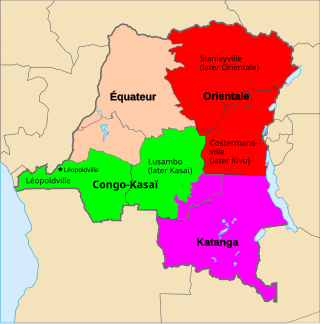
Ground transport in the Democratic Republic of the Congo (DRC) has always been difficult. The terrain and climate of the Congo Basin present serious barriers to road and rail construction, and the distances are enormous across this vast country. Furthermore, chronic economic mismanagement and internal conflict has led to serious under-investment over many years.

Katanga was one of the four large provinces created in the Belgian Congo in 1914. It was one of the eleven provinces of the Democratic Republic of the Congo between 1966 and 2015, when it was split into the Tanganyika, Haut-Lomami, Lualaba, and Haut-Katanga provinces. Between 1971 and 1997, its official name was Shaba Province.

Pakistan Railways is the national, state-owned railway company of Pakistan in Lahore. Founded in 1861 as the North Western State Railway and headquartered in Lahore, it owns 7,490 kilometres of operational track across Pakistan, stretching from Torkham to Karachi, offering both freight and passenger services, covering 1,184 stations across Pakistan.
The railways of New South Wales, Australia have had many incidents and accidents since their formation in 1831. There are close to 1000 names associated with rail-related deaths in NSW on the walls of the Australian Railway Monument in Werris Creek. Those killed were all employees of various NSW railways. The details below include deaths of employees and the general public.
The Benaleka train accident occurred on August 1, 2007 near Benaleka in the Democratic Republic of Congo, killing at least 100 people and seriously injuring 128 more.
The Yanga derailment occurred on 21 June 2010 when a train traveling between Brazzaville and Pointe Noire in the Republic of the Congo was derailed and plunged into a ravine. At least 60 people were initially reported to have been killed and hundreds disappeared with the death toll expected to rise further. The death toll had risen to 76 people and the injury toll had risen to 745 by 23 June 2010.

The Naro-Fominsk rail crash occurred on 20 May 2014 when a freight train derailed near Naro-Fominsk, Moscow Oblast, Russia. The train was run into by a passenger train. Nine people were killed and 51 were injured.




